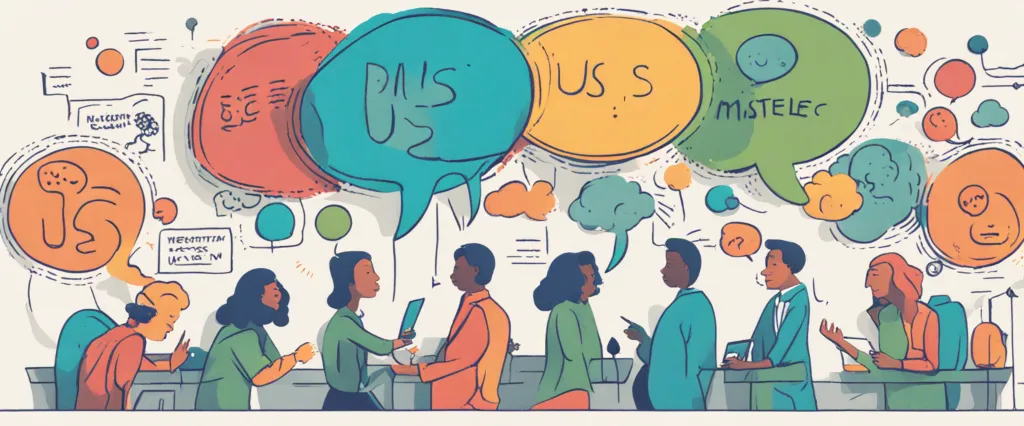In “Me, Myself, and Us,” Brian Little delves into the intricacies of our personality, exploring how it shapes our lives and influences our behavior. By drawing on his extensive research in psychology and his own personal experiences, Little presents a captivating and insightful examination of the interaction between nature and nurture. A renowned personality psychologist, Brian Little is a professor at Cambridge University and has spent decades studying the complexities of personality traits and their impact on our lives. With his expertise and engaging writing style, Little offers readers a fresh perspective on understanding ourselves and embracing our unique individuality.
Chapter 1: Introduction to Personality and Identity
Chapter 1 of “Me, Myself, and Us” by Brian Little serves as an introduction to the topics of personality and identity. The chapter explores various aspects of personality, such as the different theories and perspectives used to understand it.
Little begins by highlighting the richness and complexity of human personality, emphasizing that each person’s personality is unique and influenced by both genetic and environmental factors. He explores the debates surrounding the determinants of personality, addressing the ongoing nature versus nurture debate.
The chapter also touches on the various theories of personality, including psychoanalysis, behaviorism, and humanistic approaches. Little explains that these theories provide different lenses through which to view and understand personality, each with its own strengths and limitations.
Furthermore, Little introduces the concept of personal projects, which are the goals and aspirations individuals pursue in their daily lives. He explains that personal projects play a significant role in shaping personality and identity. Understanding these personal projects can help us gain insights into who we are as individuals.
Towards the end of the chapter, Little describes the importance of considering both the individual and societal aspects of personality. He suggests that our identities are influenced by social group membership and cultural norms, and therefore, understanding personality requires exploring the impact of these external factors.
In summary, chapter 1 of “Me, Myself, and Us” introduces readers to the multifaceted nature of human personality and identity. It provides an overview of the different theories and approaches used to understand personality while emphasizing the role of personal projects and societal influences in shaping individual identities.
Chapter 2: The Core Traits of Personality
Chapter 2 of “Me, Myself, and Us” by Brian Little explores the core traits of personality, specifically the Big Five personality traits and the psychology behind them. These traits include extroversion, neuroticism, agreeableness, conscientiousness, and openness to experience.
The chapter begins by highlighting that these traits are not simply binary categories but exist on a continuum. People may possess varying degrees of each trait, and these traits can influence how individuals respond to different situations. For instance, extroverts tend to be outgoing, energized by social interactions, and enjoy being the center of attention. On the other hand, introverts prefer solitude, require less external stimulation, and may find socializing draining.
Neuroticism focuses on an individual’s emotional stability or instability. Those with high neuroticism may exhibit intense negative emotions, experience anxiety, and be more prone to mood swings. Agreeableness examines the level of a person’s compassion, empathy, and cooperativeness. Highly agreeable individuals tend to be caring, trusting, and prioritize maintaining harmonious relationships.
Conscientiousness refers to traits such as organization, reliability, and self-discipline. Conscientious individuals are often goal-oriented, pay attention to detail, and have strong impulse control. Finally, openness to experience measures an individual’s curiosity, imagination, and appreciation for art and culture. Open individuals tend to be creative, adventurous, and embrace novel ideas and experiences.
The chapter also delves into the influence of genes and environments on these core traits. While genetics plays a significant role in determining personality, environmental factors, such as upbringing and culture, also contribute to shaping these traits.
In summary, Chapter 2 of “Me, Myself, and Us” provides an overview of the Big Five personality traits – extroversion, neuroticism, agreeableness, conscientiousness, and openness to experience – and emphasizes their multidimensional nature. It explores how these traits influence an individual’s behavior, thoughts, and emotional states, showcasing the complex interplay between genetics and environment in shaping our personalities.
Chapter 3: Free Traits and Authenticity
Chapter 3: Free Traits and Authenticity, from the book Me, Myself, and Us by Brian Little, explores the concept of free traits and how they relate to authenticity. Free traits refer to the behavior patterns individuals adopt temporarily to meet the demands of certain situations or roles, even if those patterns are not consistent with their underlying personality traits.
Little explains that although we have certain fixed traits that define our basic nature, we also have the capacity to behave in ways that go against those traits in order to meet specific goals or expectations. He uses the example of an introverted person who takes on an extraverted role, such as giving a public speech, to demonstrate the concept of free traits.
Authenticity, on the other hand, refers to behaving in alignment with our true selves or core traits. Little argues that although free traits may contradict our underlying nature, engaging in them can still be authentic if they are motivated by our personal values, goals, or commitments. In fact, embracing free traits that are counter to our fixed traits can have positive outcomes, as they allow us to grow, adapt, and connect with others.
However, Little also notes that the constant adoption of free traits can be mentally and emotionally draining. He emphasizes the importance of self-care and providing oneself with opportunities to engage in activities that align with one’s core traits to replenish energy and maintain authenticity.
Overall, Chapter 3 explores the complex relationship between fixed traits, free traits, and authenticity. It highlights the idea that while free traits can be temporarily adopted, being authentic means embracing these patterns in ways that are consistent with our personal values and goals.
Chapter 4: Biogenic, Sociogenic, and Idiogenic Sources of Personality

Chapter 4 of “Me, Myself, and Us” by Brian Little explores the biogenic, sociogenic, and idiogenic sources of personality. The chapter highlights the complexity of understanding individual personalities, emphasizing the influence of both biological and environmental factors.
The discussion begins with a focus on biogenic sources, which refer to biological or genetic influences on personality. Little explains that traits such as introversion or extroversion may have some genetic basis. He delves into the concept of dopamine levels and their role in shaping personality, suggesting that individuals with higher dopamine levels are more likely to exhibit extroverted behaviors.
Moving on to sociogenic sources, the chapter examines the impact of social and cultural factors on personality development. Little argues that society’s expectations and norms greatly influence the way individuals express their personalities. He explores cases where individuals may suppress their true nature due to social pressure or conform to societal expectations. This section emphasizes the important role of socialization in shaping personality.
Lastly, Little discusses idiogenic sources, which refer to personal choices and self-determined behaviors. This section emphasizes the agency individuals have in shaping their own personalities. It explores how one’s personal goals, values, and self-concept play a significant role in developing and expressing their personality.
Throughout the chapter, Little provides a comprehensive overview of the multifaceted nature of personality development. He emphasizes the interplay between biological, social, and personal factors in shaping who we are. By recognizing the impact of various sources, individuals can gain insight into their own personality and make conscious choices to align their behavior with their genuine selves.
Chapter 5: The Role of Personal Projects in Shaping Identity
Chapter 5 of “Me, Myself, and Us” by Brian Little explores the role of personal projects in shaping one’s identity. Personal projects refer to the various goals, activities, and commitments that individuals engage with in their daily lives. Little argues that these projects play a significant role in influencing and shaping an individual’s sense of self.
The chapter starts by discussing the concept of self-discrepancy theory, which suggests that people compare their actual self (how they currently perceive themselves) with their ideal self (how they aspire to be) and their ought self (the version of themselves that societal norms and obligations demand). Personal projects can bridge the gaps between these different selves and help individuals align their identity with their desired self.
Little introduces the concept of core projects, which are a small set of personal projects that are deemed highly important to an individual’s sense of self. These projects hold great meaning, provide a sense of purpose, and help shape one’s self-identity. Little emphasizes that core projects are not fixed but evolve throughout an individual’s life as their values, priorities, and circumstances change.
The chapter also explores the psychology behind choosing personal projects and how they contribute to identity development. Personal projects provide individuals with a source of agency, allowing them to express their values, passions, and unique talents. By identifying and engaging in projects that align with their core values and interests, individuals can gain a greater sense of authenticity and fulfill their psychological needs.
Furthermore, Little delves into the role of self-signaling and self-verification in personal projects. Self-signaling refers to the ways in which individuals use their personal projects to communicate their identity to others, while self-verification involves engaging in projects that reinforce one’s existing self-views.
Overall, Chapter 5 emphasizes the importance of personal projects in shaping one’s identity and how they serve as a means for individuals to express their true selves, bridge self-discrepancies, and gain a greater sense of purpose and authenticity.
Chapter 6: The Quiet Revolution of Personality
Chapter 6 of the book “Me, Myself, and Us” by Brian Little explores the concept of the Quiet Revolution of Personality. The chapter highlights how introverts and extroverts approach life differently, challenging the assumption that extroversion is the ideal personality type.
The Quiet Revolution begins by acknowledging that society often favors extroverted traits, such as assertiveness, outgoingness, and gregariousness. It is often the case that people who possess these traits are seen as more confident, successful, and happier. However, Little argues that introverts have unique strengths of their own.
The chapter delves into the research on introversion, revealing that introverts have a greater predisposition toward self-regulation, thinking deeply, and reflecting on their experiences. This introspective nature enables them to engage in profound levels of self-growth and personal development. They are often more focused, observant, and thoughtful, allowing them to cultivate rich internal worlds and exhibit high levels of creativity and insight.
Little also discusses how introverts can navigate extroverted aspects of life while still honoring their natural tendencies. He explains that introverts can develop adaptive strategies, like adopting an extroverted self when necessary, to succeed in social situations without compromising their true nature. These strategies can include selective socializing, finding niches that suit their personality, and utilizing their ability to listen attentively and empathetically.
Moreover, the chapter emphasizes the importance of embracing and understanding introversion as a valuable personality trait both individually and within society. It argues for the recognition of diverse personality types and for creating environments where individuals can thrive according to their innate tendencies, rather than solely favoring extroverted traits.
In conclusion, Chapter 6 of “Me, Myself, and Us” advocates for the celebration and understanding of introversion, challenging the societal bias toward extroversion. It explores the strengths and unique qualities introverts possess and encourages individuals to honor and harness their introverted nature to lead fulfilling lives.
Chapter 7: Personality and Relationships
Chapter 7 of “Me, Myself, and Us” by Brian Little explores the intriguing relationship between personality and relationships. The author delves into how we tend to seek out and interact with individuals whose characteristics complement our own, as well as the impact of personality on general relationship satisfaction.
Little begins by discussing the concept of assortative mating, which refers to the tendency for individuals to choose partners who share similar attributes. He explains that this preference for similarity occurs in terms of both disposition and demographic variables. For instance, introverts may be more likely to form relationships with other introverts, while individuals with higher educational backgrounds may gravitate towards those with similar achievements.
The author further discusses the influence of positive affectivity or happiness on relationships. Little explains how individuals with higher levels of positive affectivity are more likely to have more satisfying and harmonious relationships. These individuals have a greater tendency to engage in positive interactions, leading to stronger bonds with their partners.
Furthermore, Little explores how personality traits such as conscientiousness and agreeableness play a prominent role in relationships. Individuals who are more conscientious tend to have more stable and committed partnerships, as they are reliable and accountable. Agreeableness, on the other hand, contributes to compatibility and harmony in relationships due to traits such as compassion and cooperation.
The chapter also delves into the fascinating field of interpersonal perception. Little explains how individuals with high self-verification strivings desire partners who support and validate their self-concept, whereas those with high self-enhancement motives may seek partners who enhance their self-image.
Overall, Chapter 7 provides a comprehensive exploration of the complex relationship between personality and relationships, highlighting how personality traits influence partner selection, relationship satisfaction, and interpersonal perception.

Chapter 8: Cultivating Our Best Possible Selves
Chapter 8 of “Me, Myself, and Us” by Brian Little focuses on cultivating our best possible selves. Little begins by discussing the concept of the “Ideal Self,” which refers to the person we aspire to be or the attributes we consider important in achieving personal growth and fulfillment. He argues that striving to become our Ideal Self is a fundamental human desire and explores various strategies to cultivate these qualities.
One strategy is to engage in activities that align with our personal values, goals, and interests. Little emphasizes the importance of pursuing activities that provide a sense of intrinsic motivation and satisfaction, as these are more likely to lead to personal growth. He also advises individuals to be self-reflective and identify their strengths, weaknesses, and core values.
The chapter also delves into the notion of “meandering pathways,” which highlights the significance of trying out different paths in life to discover what truly matters to us. Little encourages readers to be open to new experiences, take risks, and embrace unexpected opportunities to explore new paths that may lead to personal growth.
Moreover, the author emphasizes the importance of maintaining a positive mindset and resilience in the face of challenges and setbacks. By adopting a growth mindset, individuals can view failures as learning experiences and continue to develop and cultivate their best possible selves.
In conclusion, Chapter 8 of “Me, Myself, and Us” provides valuable insights and practical strategies for cultivating our best possible selves. By aligning our actions with our values, exploring new paths, building resilience, and maintaining a positive mindset, we can strive towards becoming the individuals we aspire to be.
After Reading
In “Me, Myself, and Us” by Brian Little, the author explores the concept of personality and its impact on our lives. Through various examples and research, Little demonstrates that while we may have a sense of a fixed personality, it is actually more fluid, shaped by situations and circumstances. He presents the idea that individuals possess a core self but also have the capacity to adapt and grow. Furthermore, Little asserts that embracing our true selves and aligning our lives with our core values can lead to greater happiness and fulfillment. By debunking the notion of a rigid personality, the book encourages readers to embrace the idea that we have the power to shape our own destinies and live more authentic lives.
1. The Power of Introverts in a World That Can’t Stop Talking” by Susan Cain – This book explores the value of introversion in a predominantly extroverted society. It delves into the characteristics, strengths, and unique abilities of introverts and provides insights into how introverts can thrive in an extroverted world.
2. “Quiet: The Power of Introverts in a World That Can’t Stop Talking” by Susan Cain – Similar to the first recommendation, Susan Cain’s book challenges the notion that extroversion is always preferred and highlights the power of introverts in various aspects of life, including creativity, leadership, and relationships.
3. “The Highly Sensitive Person: How to Thrive When the World Overwhelms You” by Elaine N. Aron – This book examines the trait of high sensitivity and provides guidance on how to better understand and embrace this characteristic. It offers insights, strategies, and self-care techniques for highly sensitive individuals to lead fulfilling lives.
4. “Self-Compassion: The Proven Power of Being Kind to Yourself” by Kristin Neff – Drawing on scientific research, this book explores the importance of self-compassion in our lives. It provides practical exercises, techniques, and strategies to develop self-compassion, which can lead to increased happiness, resilience, and overall well-being.
5. “Personality: What Makes You the Way You Are” by Daniel Nettle – This book investigates different personality traits by exploring the complex interplay between genetics, environment, and personal experiences. It unravels how our personalities shape who we are and sheds light on the various factors that contribute to our unique identities.




